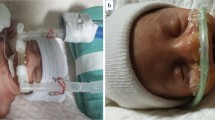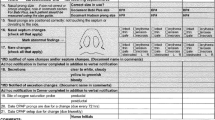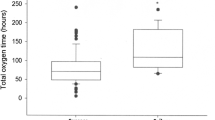Abstract
OBJECTIVE: We studied the association between the use of oxygen cannulas (OCs) and (1) nasal bleeding and (2) coagulase-negative staphylococcal sepsis (CNSS).
STUDY DESIGN: Review of care sheets, with χ2 or sign-test group comparisons.
RESULTS: Infants treated with OCs were suctioned more frequently (2.6 vs 1.3 times per day, p<0.001), and had more bloody nasal secretions (34.6% vs 4.6%, p<0.05) that increased with increasing OC days. By 10 days, 90% of infants had experienced bloody secretions.
CNSS occurred less often in infants treated with oxyhoods than those on OC or CPAP (1 of 13, 8%, vs 10 of 44, 23%), but the difference was not significant. Eight of the 10 CNSS episodes clustered within 3 and 7 days of starting CPAP or cannula treatments.
CONCLUSION: OC use in extremely low birthweight infants is associated with nasal mucosal injury and bleeding. Studies are needed to see if use of OCs is a risk factor for CNSS.
This is a preview of subscription content, access via your institution
Access options
Subscribe to this journal
Receive 12 print issues and online access
$259.00 per year
only $21.58 per issue
Buy this article
- Purchase on Springer Link
- Instant access to full article PDF
Prices may be subject to local taxes which are calculated during checkout



Similar content being viewed by others
References
D'Angio CTR, McGowan KL, Baumgart S, St Geme J, Harris MC . Surface colonization with coagulase-negative staphylococci in premature neonates. J Pediatr 1989;114(6):1029–1034.
Ahmuda CA, Goldsmith JP . Continuous distending pressure. In: Goldsmith JP, Karotkin EH, editors. Assisted Ventilation of the Neonate, 3rd ed. Philadelphia, PA: Saunders; 1996.
Sreenan C, Lemke RP, Hudson-Mason A . High-flow nasal cannula in the management of apnea of prematurity: A comparison with conventional positive airway pressure. Pediatrics 2001;107:1081–1083.
Vermont Oxford Network Second Annual Quality Congress for Neonatology, Washington, DC, December 9, 2001, poster # 23.
Carlo WA, Martin RJ, Bruce EN, Strohl KP, Fanaroff AA . Aloe nasi activation (nasal flaring) decreases nasal resistance in preterm infants. Pediatrics 1983;72(3):338–343.
Polgar G, Kong GP . The nasal resistance of newborn infants. J Pediatr 1965;67(4):557–567.
Brodie SB, Sands KE, Gray JE, et al. Occurrence of nosocomial bloodstream infections in six neonatal intensive care units. Pediatr Infect Dis J 2000;19(1):56–65.
Courtney SE, Pyon KH, Saslow JG . Lung recruitment and breathing pattern during variable versus continuous flow nasal continuous positive airway pressure in premature infants: An evaluation of three devices. Pediatrics 2001;107:304–308.
Author information
Authors and Affiliations
Rights and permissions
About this article
Cite this article
Kopelman, A., Holbert, D. Use of Oxygen Cannulas in Extremely Low Birthweight Infants is Associated with Mucosal Trauma and Bleeding, and Possibly with Coagulase-negative Staphylococcal Sepsis. J Perinatol 23, 94–97 (2003). https://doi.org/10.1038/sj.jp.7210865
Published:
Issue Date:
DOI: https://doi.org/10.1038/sj.jp.7210865
This article is cited by
-
Nasal masks or binasal prongs for delivering continuous positive airway pressure in preterm neonates—a randomised trial
European Journal of Pediatrics (2017)
-
Applications of Nasal High-Flow Oxygen Therapy in Critically ill Adult Patients
Lung (2016)
-
High-flow nasal cannula and extubation success in the premature infant: a comparison of two modalities
Journal of Perinatology (2010)
-
Effect of silicon gel sheeting in nasal injury associated with nasal CPAP in preterm infants
Indian Pediatrics (2010)
-
Nasale cpap: een kwaliteitsverbetering bij prematuur geboren kinderen
Tijdschrift voor kindergeneeskunde (2007)



